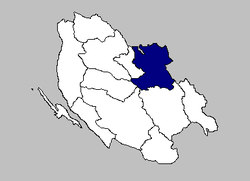Plitvička Jezera
| Plitvička Jezera | |
|---|---|
| Municipality | |
 | |
 Plitvička Jezera | |
| Coordinates: 44°52′N 15°37′E / 44.867°N 15.617°E | |
| Country | Croatia |
| County | Lika-Senj |
| Government | |
| • Mayor | Ivica Kukuruzović (HDZ) |
| Area | |
| • Total | 539.08 km2 (208.14 sq mi) |
| Elevation | 612 m (2,008 ft) |
| Population (2011)[1] | |
| • Total | 4,373 |
| • Density | 9/km2 (20/sq mi) |
| Time zone | CET (UTC+1) |
| • Summer (DST) | CEST (UTC+2) |
| Postal code | 53 231 |
| Area code(s) | 053 |
| Website | www.tzplitvice.hr |
Plitvička Jezera (pronounced [plîtv̞itʃkaː jɛzɛ̌ra] or just Plitvice [plîtv̞itsɛ]; Plitvice Lakes, in English) is a municipality (općina) in central Croatia, in the eastern part of the Lika-Senj county, that lies in and near the eponymous Plitvice Lakes National Park, bisected by the D1 main road (Zagreb–Split). Its total area is 539.08 km². The main town and seat of the municipality is Korenica. Other smaller towns and villages are Bjelopolje, Jezerce, Gornji Vaganac, Ličko Petrovo Selo, Plitvice and Smoljanac.
Demographics
According to 2001 census, its total population was 4,668. The ethnic composition of Plitvička Jezera was 67.3% Croat and 30.5% Serb. In the 2011 census, the population dropped to 4,373, of which 70,11% were Croats and 27,08% were Serbs. The pre-war numbers show a Serb majority.[citation needed]
The settlements in the municipality are:[2]
- Bjelopolje
- Čanak
- Čujića Krčevina
- Donji Babin Potok
- Donji Vaganac
- Drakulić Rijeka
- Gornji Babin Potok
- Gornji Vaganac
- Gradina Korenička
- Homoljac
- Jasikovac
- Jezerce
- Kalebovac
- Kapela Korenička
- Kompolje Koreničko
- Končarev Kraj
- Korana
- Korenica
- Kozjan
- Krbavica
- Ličko Petrovo Selo
- Mihaljevac
- Novo Selo Koreničko
- Oravac
- Plitvica Selo
- Plitvička Jezera
- Plitvički Ljeskovac
- Poljanak
- Ponor Korenički
- Prijeboj
- Rastovača
- Rešetar
- Rudanovac
- Sertić Poljana
- Smoljanac
- Šeganovac
- Trnavac
- Tuk Bjelopoljski
- Vranovača
- Vrelo Koreničko
- Vrpile
- Zaklopača
- Željava
History
During the Croatian War of Independence and the Krajina uprising, many areas were mined to stop enemy advances. The area around Korana Bridge has recently been demined,[3] but there are still some others still suspected to be mine contaminated, as for reports from the local NGO Croatian Mine Action Centre.[4]
Many local inhabitants of Serb ethnicity left the municipality during the war, with around 1,500 - 2,000 of them returning once the situation improved.[5]
Economy
It is most famous for the Plitvice Lakes National Park, a major tourist destination and its main source of income, together with arable lands, grazing lands and woods. Due to the Plitvice Lakes National Park unique geological evolution and beauty, it was entered in the UNESCO world heritage list in 1979.
According to Human Rights Watch, many of the ethnic Serbian returnees were experiencing a higher unemployment rate, and were also being "excluded from work in municipal or town-run services and institutions, including the National Park".[5]
See also
Notable natives and residents
References
- ↑ "Population contingents, by towns/municipalities, census 2001". Croatian Bureau of Statistics. Retrieved 2008-12-29.
- ↑ "SAS Output". Dzs.hr. Retrieved 2014-02-01.
- ↑
- ↑
- ↑ 5.0 5.1 "Broken Promises: Impediments to Refugee Return: ENJOYMENT OF SOCIAL AND ECONOMIC RIGHTS". HRW. Retrieved 2014-02-01.
External links
- Plitvice lakes National park
- Population Data
- Tourist Board of the Municipality of Plitvice Lakes
- Plitvice lakes secondary school
| ||||||||||
Coordinates: 44°52′50″N 15°36′58″E / 44.88056°N 15.61611°E
